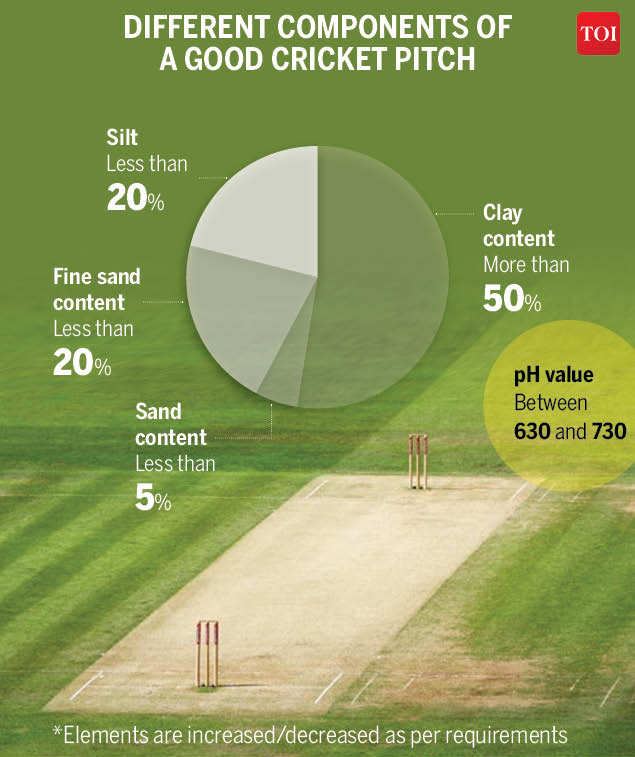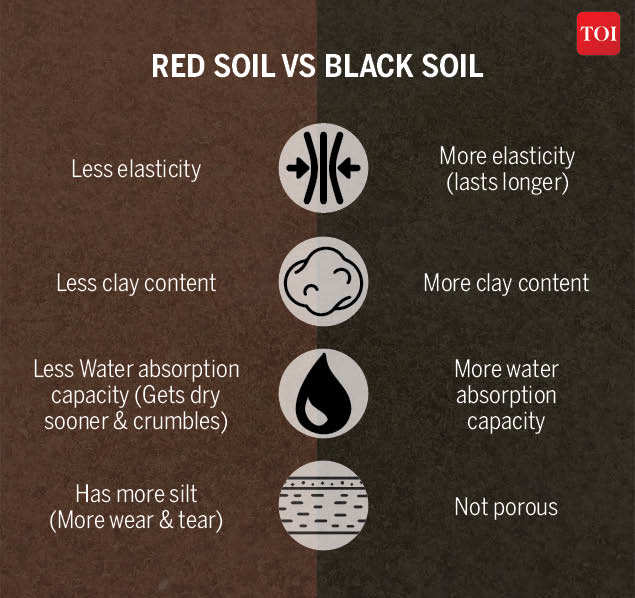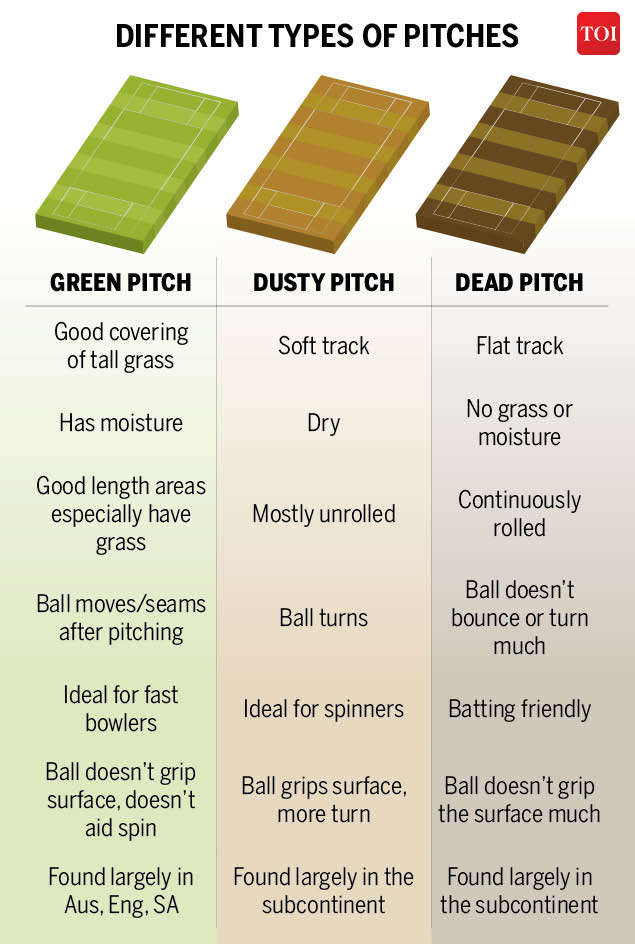Cricket pitches: All you need to know about cricket pitches: Preparation, different tracks, soil composition and characteristics | Cricket News – Times of India
That’s what sparked the pitch debate. The Chepauk pitch was called a “beach” by former England captain Michael Vaughan.
From the southeast coast, the India vs England Test series then moved up northwards to Ahmedabad. The scoreline was even at 1-1. The next match was a day-night affair, played a little over 50 km away from the banks of the Sabarmati River, at the refurbished Narendra Modi Stadium in Motera.
The topography and the colour of the soil changed, along with the colour of the ball, from red to pink; but England’s fate didn’t. In fact, it took a ‘turn’ for the worse. The day-night match was over in under two days, to become the shortest Test played since World War II in terms of balls delivered [842].
That result on another rank turner, which crumbled every time the ball pitched on it, added fuel to the fire of the pitch debate.
The raging debate went to the point that Ravichandran Ashwin got riled up during an online press conference. “Who decides what’s an ideal surface?” – the off-spinner, who reached the landmark of 400 Test wickets, asked in response to a scribe’s question. A day later, Sir Vivian Richards joined in, throwing his weight behind India and criticising the “moaning and groaning” about the pitches.
Ashwin pulls no punches! “What is a good cricket surface and who defines it?,” @ashwinravi99 to an English journali… https://t.co/S1EFYqLo8l
— Santhosh Kumar (@giffy6ty) 1614428922000
That’s the prologue, as we sit two days from the time the final chapter of the series unfolds with the fourth and last Test. The setting of the climax remains the spin-friendly Motera, but this time in the daylight, with the red ball.
In India, it’s difficult to find a layman when the context is cricket. Everybody is an expert, everybody has an opinion. But a subject as complex as cricket pitches is best left to the experts who prepare it and the players who use it.
To understand that, it was important to join the dots between the science and nature related to the topography, climate, colour of the soil, the ball, etc., as touched upon above. Those are an integral part of the factors that can decide the nature of a cricket pitch in a particular part of the world.
To dig deeper on the subject, for the layman to understand the science behind the preparation of a cricket pitch, the difference between red and black soil and more, Timesofindia.com spoke to BCCI curator Samandar Singh Chauhan, who works as chief curator with the Madhya Pradesh Cricket Association [MPCA].
BE MINDFUL OF THE FORMAT
“The first thing a curator should keep in mind is what is the format of the game. Whether it is a T20, a 50-over game, or multi-day game [domestic first class or Test],” said Chauhan. “Second, which teams are playing.”
The limited-overs format, especially T20s, is more about fours and sixes — which is the reason why even double hundreds being scored by batsmen in ODIs is not a surprise anymore. But when it comes to domestic first-class cricket or Tests, the format demands an even contest. That’s where probably some of the England experts find reason to criticise the pitches being offered in the ongoing series.
“We prepare pitches as per the format of the game. If it is a T20 game, no one wants a bowler to come and take five wickets and the match to be a low-scoring affair,” Chauhan added. “Fans expect fireworks. Everyone wants good batting pitches so that the fans can witness a lot of boundaries and sixes.”
HOW A PITCH IS PREPARED – THE PROCESS
Preparing a cricket pitch is a painstaking process. A lot of effort and science goes into preparing a good track.
Legendary Indian cricketer, selector, manager and administrator PR Umrigar (Polly Umrigar), who played 59 Tests for India between 1948 and 1962, wrote extensively on various aspects of cricket, including coaching. Later, he also wrote about pitch preparation.
These were his guidelines to prepare a bouncy pitch (see video below):
01:49How a cricket pitch is prepared
According to Umrigar, a good pitch is one “which is dry, firm, well rolled and which provides even bounce throughout, as also the pitch lasts for the duration of the match”.
WHO DECIDES WHAT KIND OF TRACK TO PLAY ON?
Is it fair for some of the England experts to blame India for preparing tracks heavily favouring their strengths, especially when every host nation is expected to have the home-ground advantage?
The home board, of course, has a say and a set of guidelines, while the home skipper can also voice his preference.
“Curators choose the pitch. They decide what surface should be there as per the format of the game. A captain can ask the home curator, not instruct, what type of pitch he is looking for,” said Chauhan talking to Timesofindia.com. “After that, the curators sit and decide, follow BCCI guidelines to take the process [forward]. Evaporation, rolling, grass process, soil compositions – these all [are the] things they chalk down.”
But the MPCA man did admit being mindful of the home team’s strength. “As a curator, I should be aware of my team’s strengths,” said Chauhan.
“If you go to Australia, you will find fast pitches. You will find 8mm to 10mm grass on it in Tests. If they make fast pitches for an ODI, they generally keep at least 6mm grass on the track.”
THE SCIENCE OF SOIL
Soil in a particular part of a world could be the key to the nature of the track. But the subject is a complicated one. There’s a lot more to it than what the naked eye can see.
Any debate on pitches will have multiple mentions about a pitch being a red-soil or a black-soil track and how that behaved, etc.
“Colour has nothing to do with the soil,” Chauhan dispelled any preconceived notions before explaining further.
“Its [soil’s] composition and characteristics are very important. How much clay content and sand content is being used is important.
“For a suitable pitch, the clay content should be more than 50 percent, the sand content should be less than 5 percent, the fine sand should be less than 20 percent, silt should be less than 20 percent, pH value should be between 630 and 730. This makes a suitable pitch. But we can increase and decrease the elements as per requirement,” said the 58-year-old Chauhan.

In most discussions around cricket pitches, the colour of the track being used is often a central theme.
Besides factors like grass left, dryness, cracks, etc., the main colour of the pitch, which is directly related to the type of soil used, has an impact on how the pitch behaves during a match.
“There is a lot of difference between red-soil and black-soil pitches. Both have different characteristics,” Chauhan further told TimesofIndia.com.
“Black soil has more elasticity and lasts for a long time. It has more clay content than red soil. Red soil has less elasticity and lasts for a short time.”

The Mumbai Test of the historic 2001 series between India and Australia ended inside three days. Still vivid in fans’ memory is Adam Gilchrist’s sublime century in Australia’s win. But what also flashes before the eyes is the striking red colour of the pitch used for the match at the Wankhede Stadium.
It crumbled as the match progressed, and eventually turned into a dust-bowl that Shane Warne and Mark Waugh used to good effect. Australia won by 10 wickets on day three.
“In Mumbai, you will find red soil, but they mix yellow soil in order to increase the clay content. Black soil has more water-holding capacity than red soil. Red soil gets dry soon and crumbles,” Chauhan explained.
“In Australia, they keep clay content to about 50 to 70 percent. That’s why they get so much bounce on tracks.”
Chauhan also threw light on how soil of the same colour in different geographical conditions can have different characteristics.
“Australian pitches are mostly black-soil pitches, but they offer much more pace and bounce than the black-soil pitches in India, which are low and slow.
“You will find three types of soil all over the world — Illite soil, Kaolinite and Smectite. Smectite is the best soil. Australians have got Smectite soil. You will find Smectite in some parts of India; Odisha and MP have Smectite soil.”
Across the world, the three predominant kinds of pitches that are seen can be broadly classified into three categories – green pitch, dusty pitch and dead pitch. As the names suggest, the three have different characteristics and are found in different parts of the world. They play differently and aid different players (batsmen/pacers/spinners).

‘WE JUST FOLLOW INSTRUCTIONS’
Speaking on behalf of the pitch curators, Chauhan said support from the management is key to the work done by the ground staff.
He lauded the BCCI in that aspect.
“BCCI has done a wonderful job. They support curators a lot and give all the facilities,” said Chauhan. “They have certain guidelines and we work according to those. We just follow instructions.”
In his concluding comment, Chauhan said it’s not impossible to prepare a bouncy track in India; but that needs backing of the management.
“I can also prepare a good bouncy pitch in Indore, but the support is very important.”


